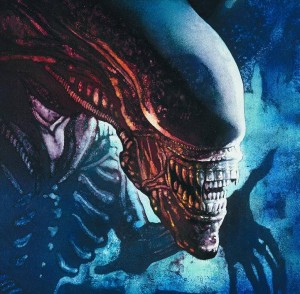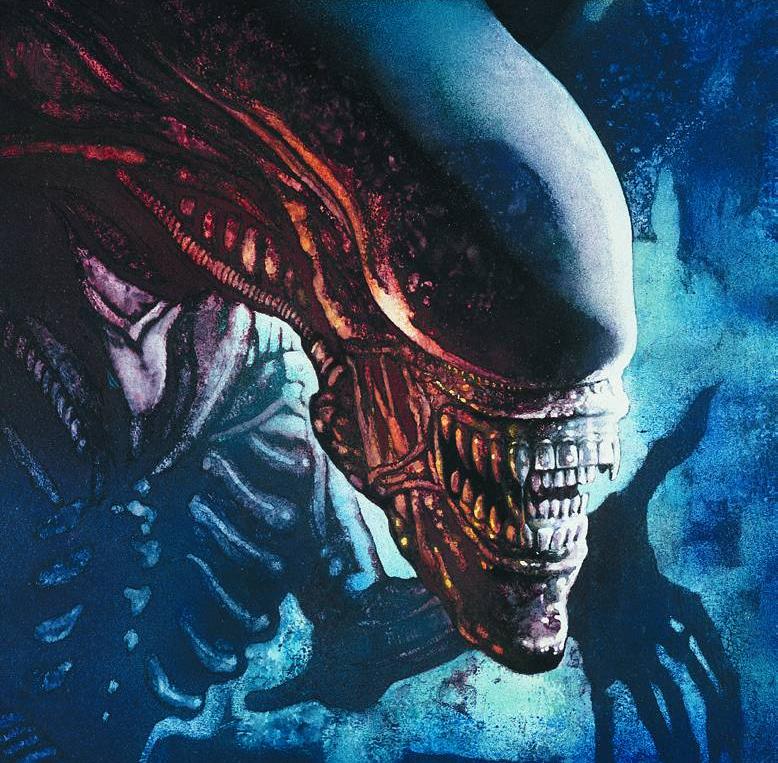 Alright, so technically this is three graphic novels. However, this is the only format they’re currently available in, so I’ll just be talking about all the stories contained within. Luckily, for this first volume, each of the stories follows the last, forming a complete epic. Also, since this is the first time I’ve talked about Dark Horse and IDW’s Omnibus editions, let me offer my highest recommendation for the format in general. This is how old material should be collected, Marvel and DC. The quicker the big two jump on this particular bandwagon, the better in my book.
Alright, so technically this is three graphic novels. However, this is the only format they’re currently available in, so I’ll just be talking about all the stories contained within. Luckily, for this first volume, each of the stories follows the last, forming a complete epic. Also, since this is the first time I’ve talked about Dark Horse and IDW’s Omnibus editions, let me offer my highest recommendation for the format in general. This is how old material should be collected, Marvel and DC. The quicker the big two jump on this particular bandwagon, the better in my book.
Now, a little bit of history before I start in on the stories proper. Most readers today know Dark Horse Comics as a sort of minor megalith in the comic industry. A demi-lith, if you will. They’re still to this day the third-largest (after DC and Marvel) comic publisher in the business, and that fact is due in no small part to the stories contained in this book. Dark Horse began as a small, indy outlet for some really talented, creative people in the black-and-white comic boom of the late 80s, but it wasn’t until one of them got the bright idea of “Hey, I really liked Aliens. I wonder if we could do some comics as, like, a sequel or something?” that the company started to skyrocket in popularity. The addition of franchises like Predator, Robocop, Godzilla, Star Wars, and Buffy the Vampire Slayer, in addition to a few successes in non-licensed comics (The Mask, Hellboy, Sin City) made them into the giant they are today.
Its important to note when talking about these stories that they were released before Alien 3, and as such didn’t fit into that film’s continuity. For later reprints of the stories, the names of Hicks and Newt were changed to “Wilks” and “Billie”, respectively. For the purposes of this review, though, I’ll be referring to them as originally intended, as its painfully obvious to anyone reading the book who the characters are supposed to be.
Book 1: Outbreak
Originally released simply as “Aliens” in 1988, Book 1 of Mark Verheiden’s post-Aliens trilogy begins ten years after the events of the titular film. Newt is living in a psychiatric facility, forever haunted by the monsters that shattered her life forever. Meanwhile, Corporal Hicks is still serving with the Colonial Marine Corps, but is considered a burnout by his superiors, as the psychological scars of his time on LV-426 have healed even worse than the hideous scarring of his face. Ten years, however, is a long time. Time enough for the Weyland-Yutani corporation to forget all about how they lost an entire colony to these creatures last time around. Time enough for them to try again.
One can’t really begin talking about this book on any other note than the artwork, as Mark Nelson’s work for this was and is truly something else. These issues were originally published in black and white, and I think it definitely shows in this color-ized version of the story. Definitely check out the original black and white version if you can at some point, as the art looks even better the way it was originally intended. However, that’s not to say it doesn’t look great here. The entire book shows a painstaking amount of detail and subtle linework that brings to life the unnerving menace of the alien creatures themselves, the decay and decadence of what human society has become under corporate rule, and the panicked emotions flitting wildly across the faces of all the myriad people affected by the events unfolding here.
As with the two other stories in this volume, Outbreak was written by Mark Verheiden, who, after writing what many still consider the definitive run on Aliens, also wrote a similar trilogy of miniseries for Predator – the first part of which served as the primary source of inspiration for the film Predator 2. His influence on the universe was felt so strongly that the character of Verheiden in the 2004 Alien vs. Predator film was named after him.
The story of Outbreak is fairly straightforward, and is in some ways what many people wanted and expected to see when they visited theaters in droves several years later for Alien 3. Needless to say, those droves were disappointed, but comic readers were not. As mentioned above, the story focuses on Hicks and Newt (no mention is made of Ripley’s fate – presumably to try and avoid conflicts with the 3rd film. So much for that idea), who after ten years of reasonably quiet, if miserable, existence, are called into action (in a manner of speaking) to pay a visit to the homeworld of those cuddly loveables they left behind on Acheron. As is typical with the franchise in general, you’ve got a lot of shadowy corporations doing naughty things behind closed doors, that lead to even naughtier things wide out in the open, with an assassin from a rival corporation trailing the ship containing Hicks’ new marine squadron and, with help from the inside, taking over the ship before they even reach their destination, leading to a lot more unpleasant time on the alien planet than the marines had planned for. Meanwhile, back on Earth, a religious nutjob has gotten hold of a magnificent hologram of an alien, and decided, “hey, looks like the Messiah to me”. Which wouldn’t be so much of an issue in and of itself, only one of the corporations has gotten hold of a queen alien, which they are of course studying and poking and prodding, and all the things Sigourney Weaver got all sweaty and panicky about people doing in the films. So Mr. I-for-one-welcome-our-new-alien-overlords and all his followers storm the corporate base, perform the “ultimate communion” with their new god (I’ll give you a hint – it involves impregnation), and then proceed to spread out as quick as they can amongst Earth’s population, because that’s what it said to do in the religious fanatic’s handbook.
While Outbreak ends on a bit of a downer note, it still manages to be a pretty rolicking tale. It reeks of that late-80s comic mentality, the early post-Watchmen days when creators were just realizing the power of the medium in front of them, as well as how dark they could go with it. Like the Alien films, Outbreak doesn’t shy away from showing us dead on all the terrifying things happening to the characters we’re starting to care about, both at the hands of the Aliens themselves, and at the hands of other humans. Unlike the films, however, we’re given lease to take a good, long look at the Alien whenever one shows up, and if you’re reading this review, then you probably understand why this is a good thing.
Book 2 – Nightmare Asylum
Nightmare Asylum picks up right where Outbreak left off, with Hicks and Newt stowing away on a cargo trawler that just barely escaped Earth before the Aliens completely overran the planet. Something, however, has changed. When we flip the page into this next chapter of the story, we’re no longer in the realm of finely-detailed linework, and precise, almost mechanical depictions of the titular antagonists. Mark Nelson’s work is done, and now we turn to airbrush artist Dennis Beauvais, a name that I think is far too little-known today, and if you read Nightmare Asylum, I think you’ll understand why it is that I feel that way. Every page of the book is lovingly airbrushed to perfection, and Beauvais’ slightly skewed framing of each scene, as well as his creative use of colors, gives the proceedings a kind of fever dream sense to them, like everything that’s happening is just beneath the line of conscious thought, and as such, is all happening much too fast to be accurately processed.
This sense of vague unreality is also very fitting to the story being told. Nightmare Asylum eschews standard trilogy formula by telling an almost completely unrelated story to Outbreak, but fitting it in the framework set up previously, and using it as a springboard into the final chapter. Nightmare Asylum is the story of one General Spears, a class-A bastard who’s managed to shoe-polish his way into the command of an entire offworld facility – one, of course, which is dedicated to studying ways to make the Aliens docile soldiers. You see, Spears thinks that if he can somehow train the Aliens they have there at the base, he can use them to retake Earth from their spiny brethren. The unfortunate part of it is, he’s completely willing to sacrifice as many humans as it takes to reach this goal, and is also suffering from a mild case of pure insanity. Enter Hicks and Newt, who arrive, after dispatching of a couple of Aliens sharing ship space with them, to find that Spears was expecting those Aliens, and he’s none too happy to hear that a couple of low-life’s from Earth had the gall to terminate his “specimens”.
The best thing about Nightmare Asylum is that, rather than utilize its premise as an excuse to give us lots of body horror and unnecessary imagery, it takes the Day of the Dead approach of having the Aliens mostly absent from the story until the very end. They’re always there, on the fringes, beautiful and menacing, patiently waiting for their opportunity to strike, and once they do, you get the best action scenes this side of Aliens itself as a payoff for the wait.
Book 3 – The Female War
Sadly, with the base destroyed and Spears dead, we must bid adieu to Mr. Beauvais’ brilliant painted work, and move on to the final chapter of our story. Now, the art duties are being handled by Sam Keith (Sandman, The Maxx), who I’ve personally never been a big fan of, and I think his work is particularly ill-suited here, but he’s quite successful, and so there must be something there that I’m just not getting. In keeping with his other work, figures in this story are very lumpy and misshapen, which works alright for the Aliens, as it gives them a kind of fluidity that was lacking in the previous chapters, but the various human characters just don’t look like they’re existing in anything approaching the real world here.
The final chapter of Verheiden’s plot picks up, again, right where Nightmare Asylum left off, with Hicks and Newt on Gateway Station, where they just happen to run into a weirdly loaded-for-bear Ellen Ripley (I realize she was armed in the film, but really? In the middle of a human space station?). Ripley explains how she was taken from the Sulaco shortly after the ending of Aliens by more corporate goons who wanted her to go on basically a repeat of the exact same mission, with almost the exact same results – Ripley and a couple of marines survive, everyone else dies. Only this time around, we haven’t spent 2+ hours getting to know the marines who survive, and so they pretty much remain faceless throughout the story. Ripley then realizes that she, Newt, and a whole lot of survivors left on Earth have been getting psychic messages from some kind of uber-Queen alien on the homeworld (which we last saw in Outbreak – at least I think its supposed to be the same planet), so she decides to go there, kidnap the uber-queen (by dressing all the surviving marines up in the power-loaders from the movie, natch), and drop her on Earth, where she’ll call all the aliens on the planet to her, and Ripley can nuke the site from orbit (heh) with some bombs left behind by a scientist guy who was killed during the initial infestation.
Yeah, it makes about as much sense to me, too. Like a lot of trilogies, this one kind of falls apart in the final act, and Keith’s artwork doesn’t help matters (Ripley looks more like Princess Leia here than herself, and Hicks looks strangely like Schwarzenegger). That being said, though, its still a decent, if disappointing, finale, to what is otherwise an excellent read.
Bonus Stuff
Because what would a lavish, long-after-the-fact reprint collection be without a few extra bits tacked on at the end? The Omnibus collections (of which there are six for Aliens alone) are an attempt to collect every single story Dark Horse previously published using the given license. Now, in the case of Aliens, I know for a fact that there’s a few they missed, but the point is that they were trying to get every little one shot story, every snippet from Dark Horse Presents and Dark Horse Comics, every special, every 0 issue they ever did. This first volume doesn’t have a whole lot of that material, but it has some that relates directly to the trilogy which forms the bulk of the book. First up is “Theory of Alien Propagation“, by Verheiden and Nelson, the team behind Outbreak, which is simply an illustrated report by a scientist (the same one that left Ripley’s nukes behind for her) on how the aliens likely live and evolve. Worthwhile just for some more Mark Nelson alien shots, if nothing else, although the “story”, such as it is, is fairly insubstantial.
The second story, “The Alien“, ties more directly in with the trilogy, although it was written by John Arcudi and illustrated by Tony Akins, neither of whom were involved with the previous stories. It deals with the immediate aftermath of The Female War, after the aliens have been mostly driven off of Earth’s surface. The Space Jockey from the end of Outbreak has come calling, intending to “repopulate” Earth – mostly sans humans. However, us humans, being the tricky, traitorous bunch that we are, send a team of disguised combat synthetics in place of the promised President and his attache group for the negotiations, and the bad alien gets all blowed up. Its a short little vignette, but satisfying in that it wraps up one of the last dangling plot threads from the trilogy with a bang.
The Verdict
Aliens Omnibus – Volume 1 is what Alien 3 should have been. Don’t get me wrong, I think Alien 3 doesn’t really get its due, and is a much better film than people tend to give it credit for being, but come on? The bugs taking over Earth? Everyone who walked out of Aliens in 1985 wanted to see that. For that fact alone Omnibus – Volume 1 is worthwhile for someone who enjoyed the original film(s). Add to that the terrific art in parts 1 and 2, and the fact that its actually a pretty terrifically well-done story, and I don’t know why we don’t go through more copies of this one. Highly recommended.


